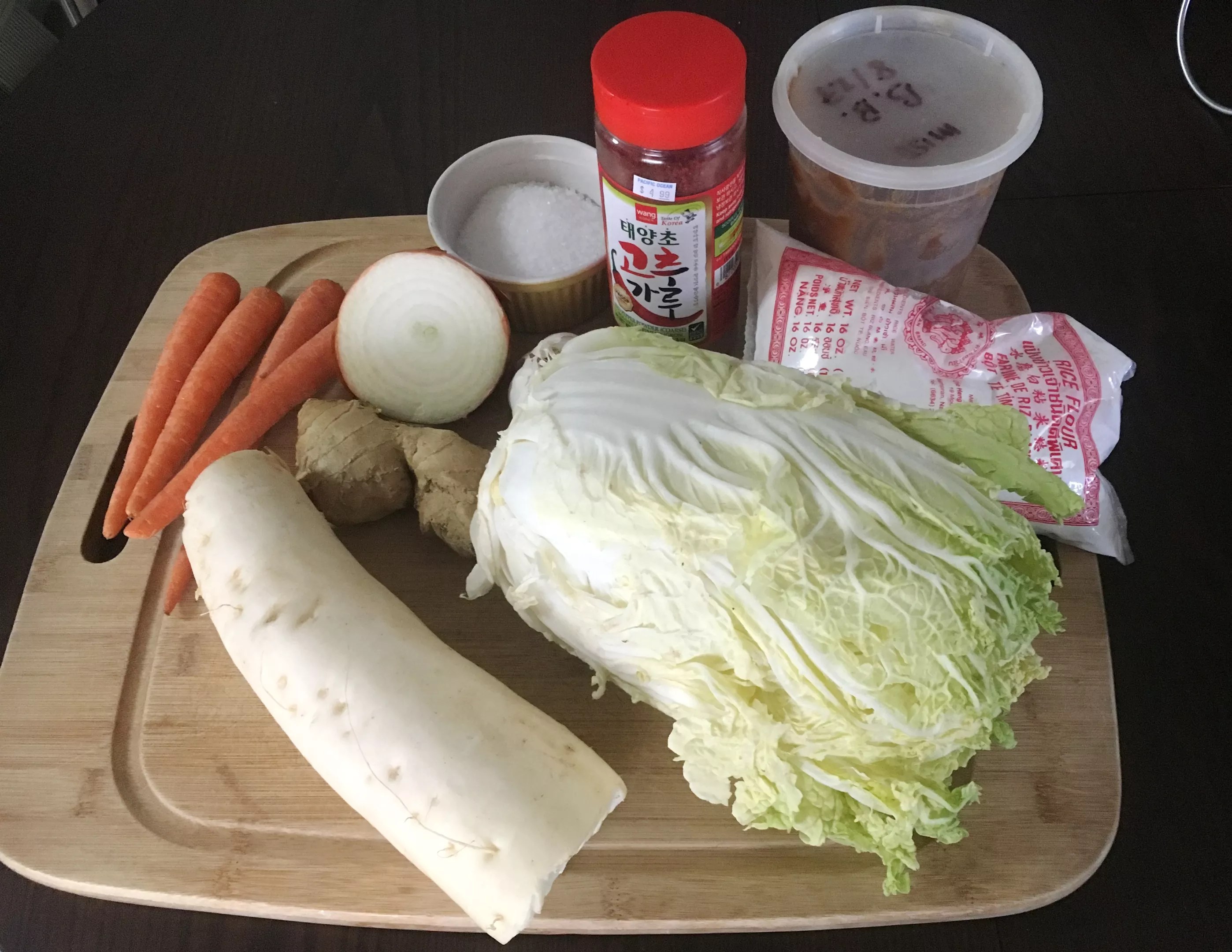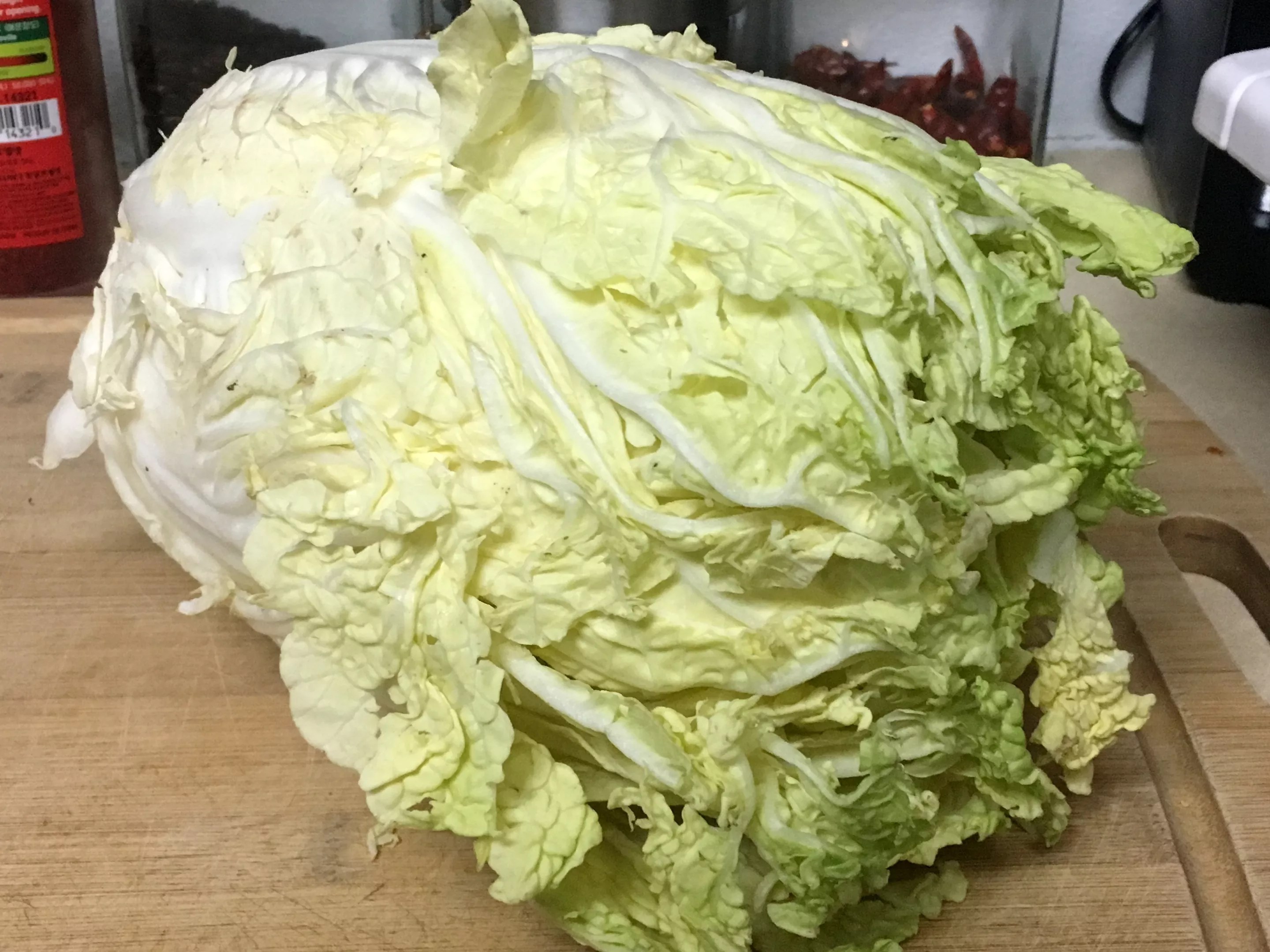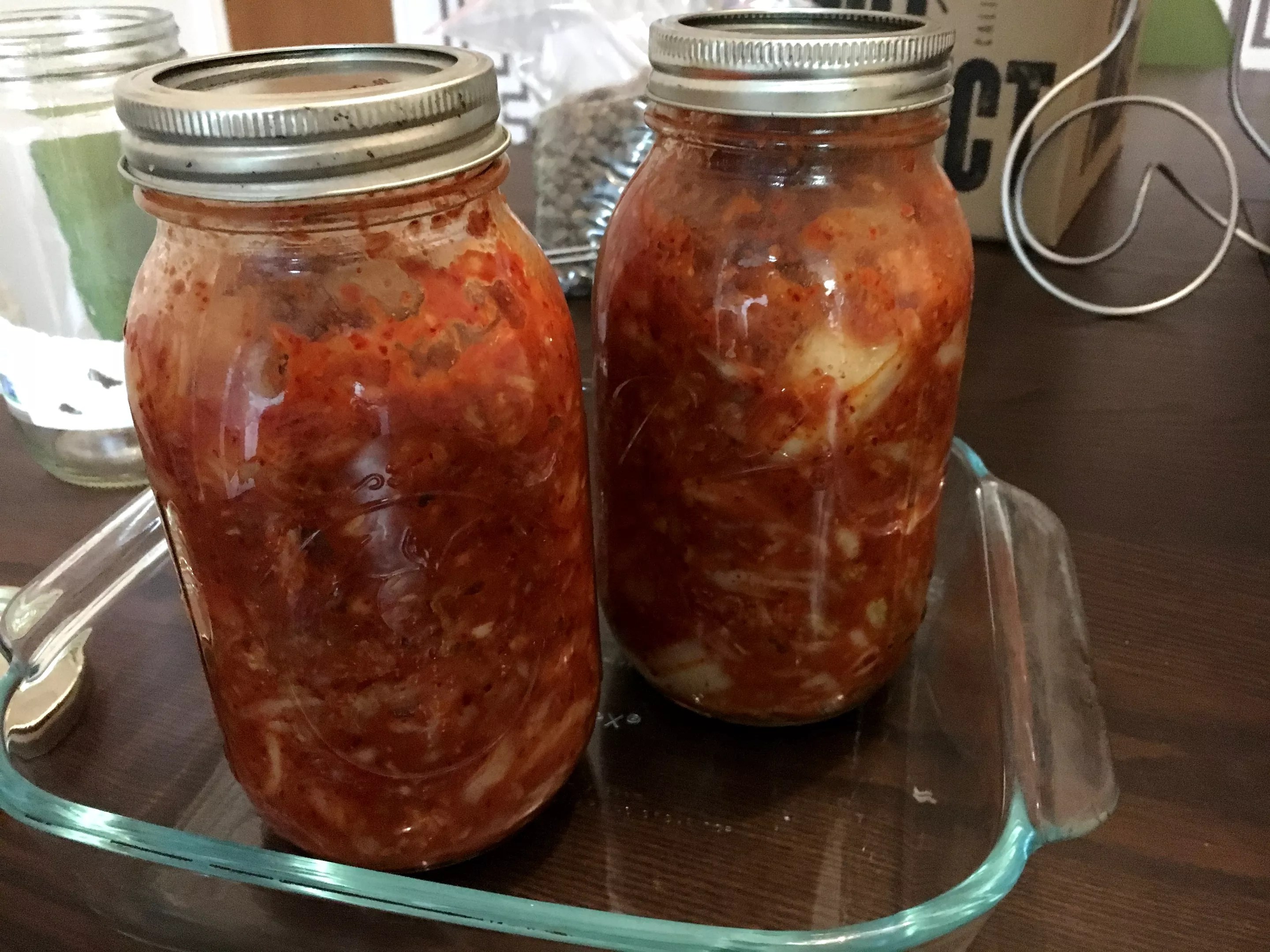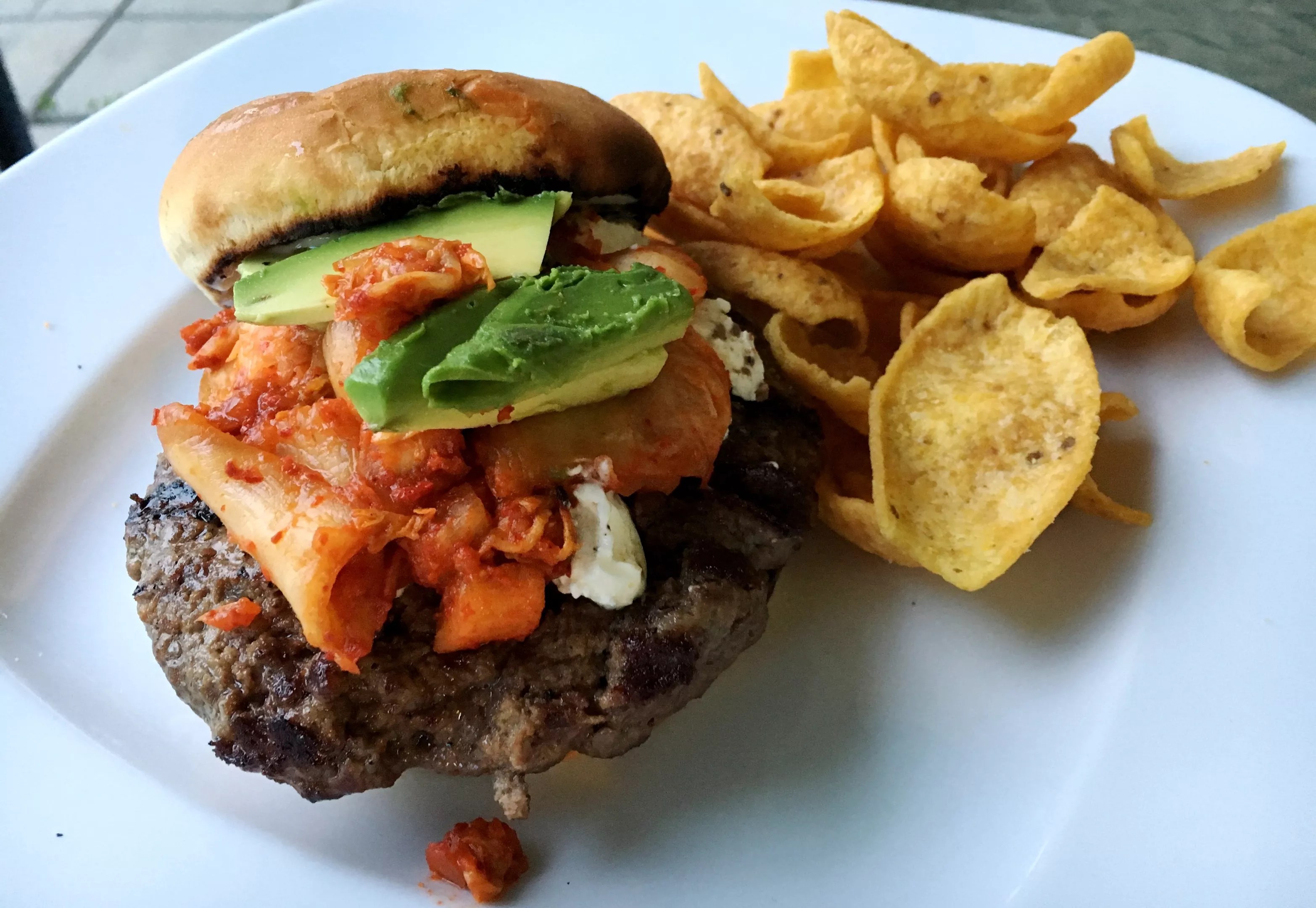
Mark Antonation

Audio By Carbonatix
Kimchi, the spicy, tangy fermented vegetable condiment found on every Korean table, is showing up more and more often on American menus in Denver. The fresh crunch, mild heat and light acidity make kimchi the perfect foil for eggs, rice, fatty meats and starchy noodles: Put it on a sandwich, stir it into soup or just grab a fork and eat it right out of the jar.
I’d been thinking about making cabbage kimchi (just one of dozens of varieties) at home, but the idea of fermenting vegetables was a little daunting. Leave it to a mom – Virgil Dickerson’s mom, in this case – to take the fear out of home cooking, and instead turn it into an exercise in comfort and sharing.

Look for a head of Napa cabbage that’s free of bruises and discoloration.
Mark Antonation
Dickerson is known around metro Denver for his work in the music community (as founder of Suburban Home Records) and developer of the Starving Artists program at Illegal Pete’s (where he was employed from 2011 until the end of last year). But he’s also an avid home cook who explains that he grew up eating a combination of Korean food and Midwestern staples, since his mom is from Korea and his dad is from Indiana.
Denver, make your New Year’s Resolution Count!
We’re $17,500 away from our End-of-Year campaign goal, with just a five days left! We’re ready to deliver — but we need the resources to do it right. If Westword matters to you, please contribute today to help us expand our current events coverage when it’s needed most.
“My mom is one of the best cooks on the planet,” Dickerson boasts (and who are we to doubt him?). “But a lot of Korean moms and grandmas don’t use recipes.”
Over the years, Dickerson observed and helped his mother cook, occasionally taking the time to write down her methods. Such was the case with her kimchi, which Dickerson admits he didn’t care for as a child; his mom would load her kimchi jjigae (a Korean stew) with hot dogs and bacon to get Virgil and his brother to eat it. Now he loves it, though, and makes it often himself. “My mom thinks it’s funny that her bratty half-American kid is now into cooking traditional Korean food,” he admits.

The recipe resulted in about a half-gallon of kimchi.
Mark Antonation
To create the recipe, Dickerson and his mom made a batch of kimchi together, and he stopped her and measured ingredients each time she added something. Here’s the result (with a few minor edits and notes for clarity); you can also find the recipe on Dickerson’s website for his new company, KREAM Konsulting, which helps small businesses with community development.
KREAM stands for “kimchi rules everything around me” – an appropriate motto for Dickerson.
Ingredients:
One head of Chinese cabbage
1/2 pound of daikon radish (diced into half-inch squares)
1/2 cup of Korean salt (or coarse kosher or sea salt, as long as it’s not iodized)
3 tablespoons of rice flour
1 1/2 cups of water (for rice-flour slurry)
1/2 yellow onion (or 6 green onions)
8 garlic cloves
2-3 tablespoons raw ginger
1/2 cup Korean gochugaru red-pepper powder (add more if you want it spicier)
3 tablespoons salted shrimp, or 3 tablespoons red miso paste, if you’re making it vegan (look for salted shrimp in jars in the refrigerated section at H Mart)
Inspect the Chinese cabbage and discard any bad leaves. Quarter the head of cabbage, cut out the triangular stalk in the cabbage and discard. Chop the cabbage into 2-inch pieces. Rinse the cabbage thoroughly and drain as much of the water as you can. Add the half-cup of Korean salt slowly into the wet cabbage, doing your best to evenly distribute the salt throughout the cabbage. Let the cabbage sit in the salt for 3 to 4 hours, stirring occasionally to continue to distribute salt throughout all the cabbage. (Use a large bowl, as there will be plenty of liquid from the cabbage by the end of this step.)
While you wait for the cabbage, boil 1 1/2 cups of water. As the water boils, slowly add the rice flour, constantly stirring. Once you’ve stirred the rice flour into the water and the water starts to boil again, put a lid on the pot and take it off the heat. Put the pot in the refrigerator for 20 to 30 minutes to cool the rice-flour mix more quickly.
In a food processor, process the onion, garlic cloves, ginger and a cup of the cooled-down rice-flour mix. Add the processed ingredients with the remaining rice-flour mix and put to the side.

Once the kimchi was ready, I tested it on a burger, along with cream cheese and avocado.
Mark Antonation
After the cabbage has been sitting for 3 to 4 hours, rinse it twice in a large tub of fresh water. Do your best to drain as much of the excess water as you can. Get the onion/garlic/ginger/rice-flour mix and add it to the cabbage. Add red-pepper powder (Dickerson likes the ChoripDong brand, but he says his mom sometimes makes her own from red Pueblo chiles she dries and powders), diced daikon and salted shrimp (or miso paste). Mix thoroughly. Taste some, and if you want more spice, add more red-pepper powder.
Jar the kimchi and let it ferment for about 48 hours at room temperature, then put it in your fridge and enjoy whenever you are in the mood for kimchi. Make sure you put it in the fridge for a little while before opening as it could explode! The kimchi will continually ferment, even in the fridge.
Taking care to use clean utensils and jars at every step will ensure that your ferment will be safe, since the salt from the recipe and the acidity created during the fermentation make a harsh environment for bad bugs.
Dickerson adds one more step at the end of the recipe: “Share with the people you love! Kimchi is meant to be shared!”